Edible, wild fungi of South Australia post #14 Pavement Mushroom (Agaricus bitorquis)
Hi everybody! Here's the lucky 14th in this ID guide for South Australian edible mushrooms. This one is about another common Agaricus, the Pavement Mushroom, Agaricus bitorquis. I've left it for a while before posting about another Agaricus because they're easy to mix up.
Before you go looking for Pavement Mushrooms, make sure you check out my old earlier post 'Intro to Agaricus Mushrooms' which contains details about on the toxic and related Yellow Stainers that look similar to these.
Pavement Mushroom (Agaricus bitorquis)

Phylum: Basidiomycota. Class: Agaricomycetes. Order: Agaricales. Family: Agaricaceae.
Agaricus bitorquis is one of the edible Agaricus mushrooms that we find around Gawler. They can be found in grassy areas, especially where the soil is dry and slightly compacted. They especially love the dirt alongside footpaths and more often than not, they’re the mushroom that you will see pushing up through footpaths and pavements in Winter. This is how their common name ‘Pavement Mushroom’ came about.
The caps of Pavement mushrooms are often discoloured by dirt and the mushroom sometimes looks a little dried out from above. Sometimes too, a Pavement Mushroom will mature below the surface of the soil and just poke some of the cap up through.
Identifying Pavement Mushrooms - a summary
- Cap is thick, flattening with age
- Flesh is white but may turn pink when exposed
- Gills are free, crowded and start pink, then become reddish brown.
- Spore print is dark brown
- Stem is thick and solid.
- The double ring around the stem is this mushroom’s distinguishing feature.
- The ring is fragile and easy to damage.


.
Agaricus bitorquis is not the most delicious of the Agaricus fungi but it’ll do in a pinch. The caps and stems are often full of critters, especially maggots, so give it a thorough going over before cooking. The few that I’ve found this year have gone straight to the compost!








Very nice! BTW, next time consider adding a few external sources so we can learn more about these things :)
I don't know many external sources, I'm self trained based of a few books and folks that I run into in the forest. The books I use are included in this old post of mine if you're interested to take a look...
https://ecency.com/hive-166168/@ligayagardener/foraging-fungi
Gotcha. Perhaps you can link the species names to a specialized website about it, similar to what you did about your earlier intro post you mention at the beginning. It could also be a nice extra touch to your post, you know.
Ooh, that's a nice chonky looking mushroom!
they're not the prettiest or tastiest but are common and edible
Yet they look so much like the mushrooms we're used to getting in the shops. I guess they would fill a hunger hole in tough times.
They're in the same Genus but not bred to be soft and scrumptious.
Congratulations @ligayagardener! You have completed the following achievement on the Hive blockchain and have been rewarded with new badge(s):
Your next target is to reach 65000 upvotes.
You can view your badges on your board and compare yourself to others in the Ranking
If you no longer want to receive notifications, reply to this comment with the word
STOPCheck out the last post from @hivebuzz:
Nice post 😉
Thanks!